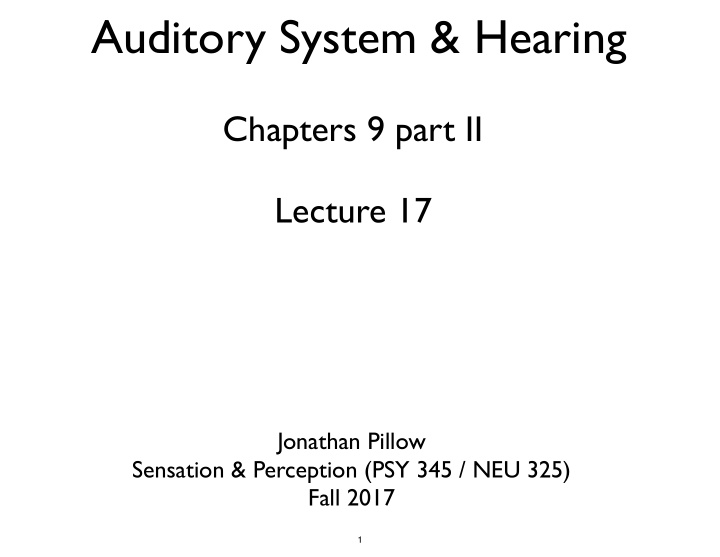



Auditory System & Hearing Chapters 9 part II Lecture 17 Jonathan Pillow Sensation & Perception (PSY 345 / NEU 325) Fall 2017 1
Cochlea: physical device tuned to frequency! • place code : tuning of different parts of the cochlea to different frequencies 2
The auditory nerve (AN): fibers stimulated by inner hair cells • Frequency selectivity : Clearest when sounds are very faint 3
Threshold tuning curves for 6 neurons (threshold = lowest intensity that will give rise to a response) threshold (dB) Characteristic frequency - frequency to which the neuron is most sensitive frequency (kHz) 4
Information flow in the auditory pathway • Cochlear nucleus : first brain stem nucleus at which afferent auditory nerve fibers synapse • Superior olive : brainstem region MGN thalamus in the auditory pathway where inputs from both ears converge • Inferior colliculus : midbrain nucleus in the auditory pathway • Medial geniculate nucleus (MGN) : part of the thalamus that relays auditory signals to the cortex 5
• Primary auditory cortex (A1) : First cortical area for processing audition (in temporal lobe) • Belt & Parabelt areas : areas beyond A1, where neurons respond to more complex characteristics of sounds 6
Basic Structure of the Mammalian Auditory System Comparing overall structure of auditory and visual systems: • Auditory system : Large proportion of processing before A1 • Visual system : Large proportion of processing after V1 7
Basic Structure of the Mammalian Auditory System Tonotopic organization : neurons organized spatially in order of preferred frequency • Starts in the cochlea • Maintained all the way through primary auditory cortex (A1) “place code” 8
• Phase locking : Firing locked to period of a sound wave • example of a temporal code Histogram showing neural spikes for an auditory nerve fiber in response to repetitions of a low-frequency sine wave 9
Psychoacoustics Psychoacoustics : The study of the psychological correlates of the physical dimensions of acoustics • A branch of psychophysics Physical Property Psychological Percept Frequency Pitch Amplitude / Intensity Loudness Q: in what ways are these relationships not exact? Pitch perception: depends on full set of harmonics (overtones) Loudness perception: depends on frequency, noise, acoustic environment 10
Equal-loudness curves • each line corresponds to tones rated by observers as having the same loudness 11
Psychoacoustics Psychoacousticians: Study how listeners perceive pitch • Masking : Using a second sound (eg, noise) to make the detection of another sound more difficult (Results were critical in the design of MP3 and other audio compression formats) 12
• Critical bandwidth : range of frequencies conveyed within a channel in the auditory system Technique for measuring bandwidth of frequency channels: • present a tone on top of a noise background • start with very narrow band of noise • increase the noise bandwidth, measure threshold for tone detection • keep increasing noise bandwidth until doing so doesn’t cause a decrease in sensitivity (increase in threshold) 13
Narrow-Band Noise 14
Broad-Band Noise 15
White Noise (equal power at all frequencies) 16
Hearing Loss: effects of noise exposure Age-related hearing loss Easter Islanders (most pronounced at high freqs) 17
Hearing Loss Hearing loss : Natural consequence of aging • Young people: frequency range of 20–20,000 Hz • By college age: 20–15,000 Hz hearing test! 18
consequences of age-related reductions in high-frequency sensitivity 1. “dispersion devices” for loitering youths - introduced in UK despite some debate over ethics / legality. 19
http://www.compoundsecurity.co.uk/security-equipment/mosquito-mk4-anti-loitering-device The Mosquito or Mosquito alarm (marketed as the Beethoven in France, the Swiss-Mosquito in Switzerland and SonicScreen in the US and Canada) is an electronic device, used to deter loitering by young people, which emits a sound with a very high frequency. The newest version of the device, launched late in 2008, has two frequency settings, one of approximately 17.4 kHz that can generally be heard only by young people, and another at 8 kHz that can be heard by most people. The maximum potential output sound pressure level is stated by the manufacturer to be 108 decibels (dB).The sound can typically only be heard by people below 25 years of age, as the ability to hear high frequencies deteriorates in humans with age. The Mosquito was invented by Howard Stapleton in 2005, and was originally tested in Barry, South Wales, where it was successful in reducing teenagers loitering near a grocery store. The idea was born after he was irritated by a factory noise when he was a child. The push to create the product was when Mr. Stapleton's 17-year-old daughter went to the store to buy milk and was harassed by a group of 12 to 15-year-olds. Using his children as test subjects, he determined the frequency of "The Mosquito."[8] Opposition categorises it as an indiscriminate weapon which succeeds only in opposition demonising children and young people and may breach their human rights. A UK campaign called "Buzz off" is calling for The Mosquito to be banned. 20
consequences of age-related reductions in high-frequency sensitivity 1. “dispersion devices” for loitering youths - introduced in UK despite some debate over ethics / legality. 2. Ringtones your professor can’t hear 21
Hearing Aides • Earliest devices were horns; today, electronic aids • Pain still kicks in at same level, so sound levels need to be compressed into detectable range 22
Cochlear implants: • Tiny flexible coils with miniature electrode contacts • Surgeons thread implants through round window toward cochlea apex • Tiny microphone transmits radio signals to a receiver in the scalp 23
Cochlear implants: • Chip performs Fourier transform and stimulates appropriate location in cochlea for each frequency • up to 22 electrodes • most effective when implanted at young age • approved by FDA in 1984 • 324,000 total recipients (through 2012) 24
Recommend
More recommend